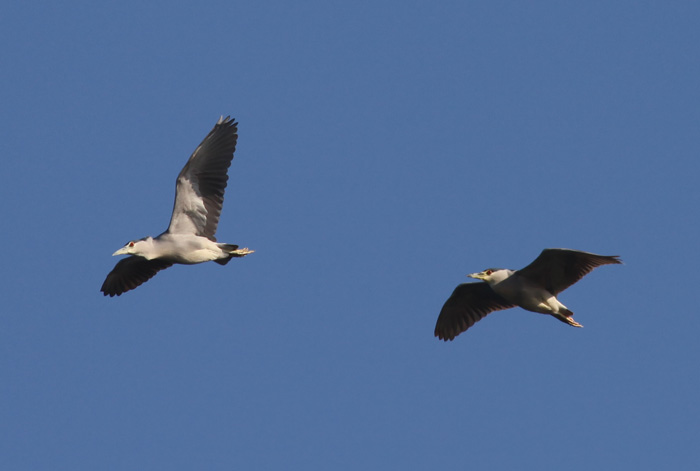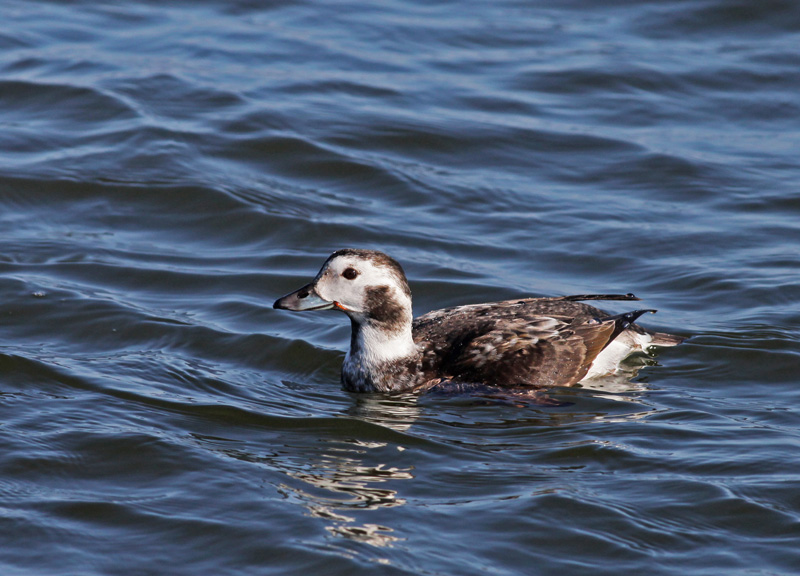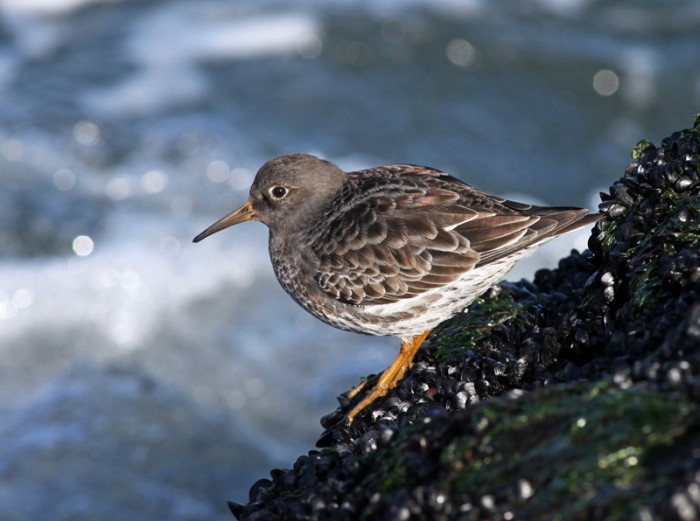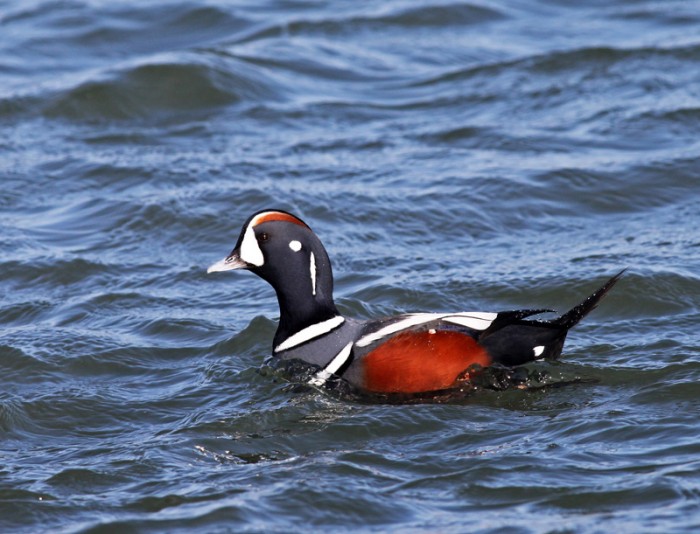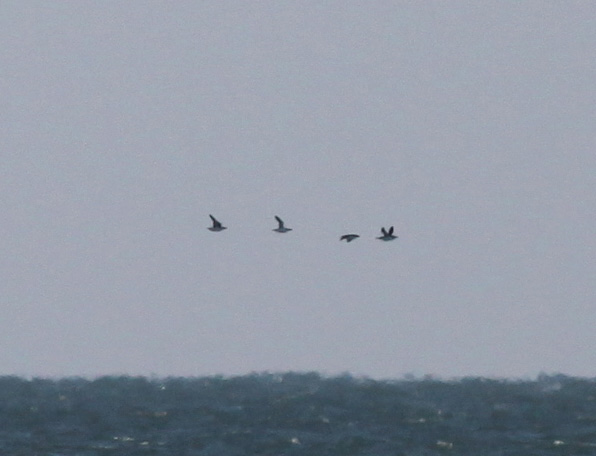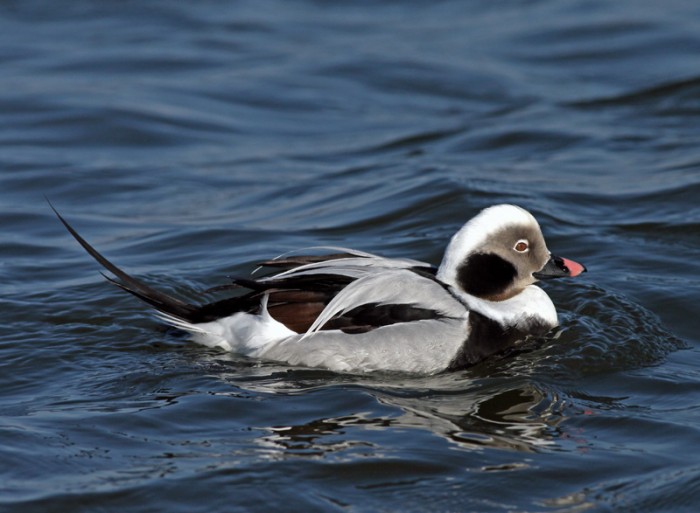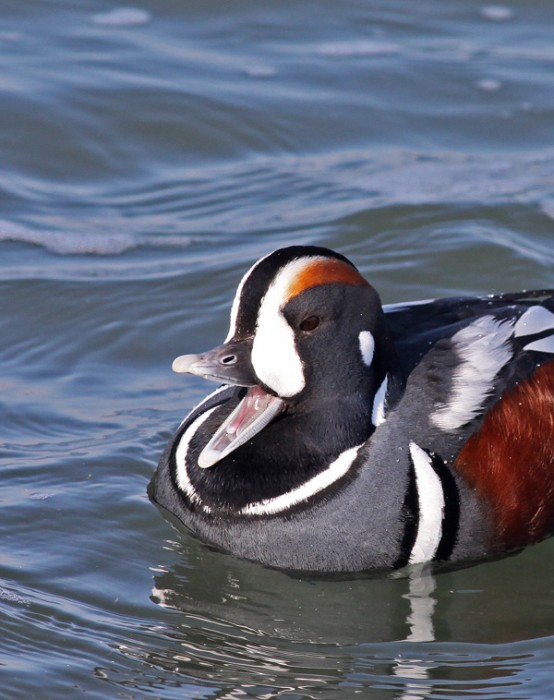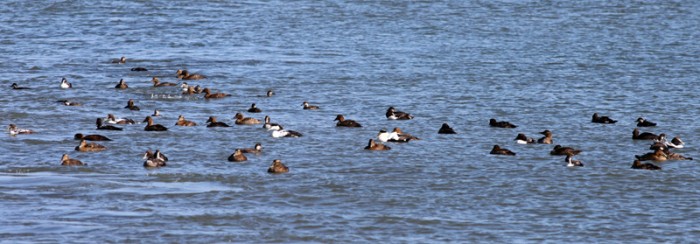Although the lapwings never came close while we were watching, we were able to get excellent views of the birds through a spotting scope. Even with the great distance from which we were watching, the green iridescence on the wings was spectacular!
Wednesday, January 23, 2013
Northern Lapwings in New Jersey
On January 14, a lucky birder found a group of three Northern Lapwings in a cow pasture in New Egypt, NJ. On Sunday, my mom and I decided to go see these unusual plovers that had somehow made their way from Europe to central New Jersey. We when arrived at the location along Brynmore Road in New Egypt, we found a number of birders set up along the roadside with spotting scopes pointed into the field. As soon as we started scanning, we spotted one of the birds. Not long after, we found the other two even farther back.
Although the lapwings never came close while we were watching, we were able to get excellent views of the birds through a spotting scope. Even with the great distance from which we were watching, the green iridescence on the wings was spectacular!
Several times as we watched, one of the lapwings raised its large wings into the air. After doing this a few times, the bird flew into the air, circled around a few times, and then landed again.
These gorgeous rarities represented yet another "lifer" that my mom and I were able to see so far this year!
Although the lapwings never came close while we were watching, we were able to get excellent views of the birds through a spotting scope. Even with the great distance from which we were watching, the green iridescence on the wings was spectacular!
Sunday, January 20, 2013
Pink-footed Goose
In the movie The Big Year, two of the main characters, Brad Harris (played by Jack Black) and Stu Preissler (Steve Martin) finish off their year of intense birding by watching a Pink-footed Goose, a bird that eluded Brad up until that point. Although I am not doing a "big year," I did not have to wait long to see this species in 2013.
On January 7, Scott Burnet discovered a Pink-footed Goose at Lake Muhlenberg in Allentown, Lehigh County, PA. This rare species is uncommon in this state and throughout the country, although it is making an impressive showing in Pennsylvania this winter! At least three have shown up in the region: one at Peace Valley Park, one at Fogelsville Quarry, and this bird at Lake Muhlenberg. Even though this goose species is quite rare in this area, Matt Loyko and Mike Moser found one at this same urban lake back in 2009.
On the morning of January 12, my mom and I decided to try for this goose that would be a lifer for both of us. We arrived around 7:00am to ensure that we could get a look at the bird before it took off around 8:00am as it had in the previous days. When we got to the spot, the entire area was covered with a dense layer of fog. As the sky got lighter, we walked through the misty air with a crowd of birders hoping for a look at the rarity.
I stopped briefly to scan the barely-visible flock when I spotted the Pink-footed Goose. It was sitting in front of the Canada Geese; its small size and white tail were evident, although we could hardly see anything more.
After a little while of sitting in place, the Pink-footed Goose slowly swam across the lake. During this time, the fog slowly began to dissipate. When the goose reached the far end of the lake, it did something totally unexpected--it stepped out onto the grass! We watched as the goose (and its uncovered pink feet) waddled on the grass for a while, occasionally pestered by some of the larger Canadas.
Look at those feet!
After about ten minutes on the grass, the Pink-foot wandered back to the water and swam all the way across the lake. By now, most of the lowest fog had lifted, although the sun was still hidden, which made photography a bit tricky.
Then, after a few honks, the goose lifted off the water with a small group of Canada Geese and headed West. In flight, the gray coloration and white tail stood out from the other birds.
The Pink-footed Goose was a lifer for me, my mom, and several of the other observers we met that morning!
On January 7, Scott Burnet discovered a Pink-footed Goose at Lake Muhlenberg in Allentown, Lehigh County, PA. This rare species is uncommon in this state and throughout the country, although it is making an impressive showing in Pennsylvania this winter! At least three have shown up in the region: one at Peace Valley Park, one at Fogelsville Quarry, and this bird at Lake Muhlenberg. Even though this goose species is quite rare in this area, Matt Loyko and Mike Moser found one at this same urban lake back in 2009.
On the morning of January 12, my mom and I decided to try for this goose that would be a lifer for both of us. We arrived around 7:00am to ensure that we could get a look at the bird before it took off around 8:00am as it had in the previous days. When we got to the spot, the entire area was covered with a dense layer of fog. As the sky got lighter, we walked through the misty air with a crowd of birders hoping for a look at the rarity.
I stopped briefly to scan the barely-visible flock when I spotted the Pink-footed Goose. It was sitting in front of the Canada Geese; its small size and white tail were evident, although we could hardly see anything more.
 |
| Our first glimpse of the Pink-footed Goose |
Look at those feet!
After about ten minutes on the grass, the Pink-foot wandered back to the water and swam all the way across the lake. By now, most of the lowest fog had lifted, although the sun was still hidden, which made photography a bit tricky.
Then, after a few honks, the goose lifted off the water with a small group of Canada Geese and headed West. In flight, the gray coloration and white tail stood out from the other birds.
The Pink-footed Goose was a lifer for me, my mom, and several of the other observers we met that morning!
Thursday, January 17, 2013
Birding Barnegat Light
Two Saturdays ago, my mom and I traveled to Barnegat Lighthouse State Park in New
Jersey. Although slightly chilly, the sun and lack of wind made the
birding conditions excellent... or at least better than on most January
days along the Jersey shore! Upon arriving, a small group of
Black-crowned Night-Herons passed directly overhead, circling around the
lighthouse several times before moving over the open water.
The "typical Barnegat" birds became visible while walking along the jetty for which the birding hotspot of Barnegat is known. Long-tailed and Harlequin Ducks swam close to shore, and Common and Red-throated Loons swam just a bit farther out in the inlet. At the start of the jetty, Long-tailed Ducks were the most cooperative species, as small groups would float up to me as I sat on the rocks with my camera. At times, these gorgeous ducks came so close that my camera could not focus.
As we went farther out on the jetty, Harlequin Ducks soon out numbered the Long-tails, with small groups of 6-8 birds loitering on the algae-covered boulders.
Whenever someone approached, the ducks would slip into the water. As soon as the "danger" had passed, the birds would wobble back out of the frigid ocean and onto the rocks.
When not milling around, the male Harlequin Ducks were busy chasing after females. Many times, groups of male Harlequins would swim up to a small group of females and chase them through the water. For the most part, the females simply scooted out of the way and ignored the males.
About halfway out on the rocks, I was sitting close to the water when two Ruddy Turnstones flew onto a nearby rock. Not minding my presence, the two birds searched for food on their rock, then fluttered over to the rock I was sitting on! For a little while, the turnstones were feeding inches from my feet!
A bit later, we came across a group of sleeping shorebirds consisting primarily of Purple Sandpipers, except for one Red Knot (the larger, paler bird):
One of the Purple Sandpipers woke up for a bit and walked to the top of the rock to stretch before taking another rest.
When I got to the very top of the jetty, I found a number of Harlequin Ducks, Black and Surf Scoters, and Common Eiders swimming in the water in this area. While not nearly as approachable as the birds closer to the shore, they still came close enough for decent photographs.
While scanning out into the ocean from this vantage point, I spotted a distant group of four Razorbills flying just above the horizon.
When I walked back part of the way to shore, a number of the brilliantly-plumaged male Long-tailed Ducks were even closer to the rocks than before. While some of the Long-tails had come close before, none of the brightest birds had been very cooperative.
One particular male Harlequin was also quite obliging... and apparently amused!
As I got off the jetty and walked along the beach, we watched a raft of about 80 Common Eiders (with a few Black Scoters mixed in) floating just offshore.
Barnegat is an incredible location for seeing amazingly beautiful species up-close. This is definitely a favorite winter birding spot of mine!
The "typical Barnegat" birds became visible while walking along the jetty for which the birding hotspot of Barnegat is known. Long-tailed and Harlequin Ducks swam close to shore, and Common and Red-throated Loons swam just a bit farther out in the inlet. At the start of the jetty, Long-tailed Ducks were the most cooperative species, as small groups would float up to me as I sat on the rocks with my camera. At times, these gorgeous ducks came so close that my camera could not focus.
As we went farther out on the jetty, Harlequin Ducks soon out numbered the Long-tails, with small groups of 6-8 birds loitering on the algae-covered boulders.
Whenever someone approached, the ducks would slip into the water. As soon as the "danger" had passed, the birds would wobble back out of the frigid ocean and onto the rocks.
When not milling around, the male Harlequin Ducks were busy chasing after females. Many times, groups of male Harlequins would swim up to a small group of females and chase them through the water. For the most part, the females simply scooted out of the way and ignored the males.
About halfway out on the rocks, I was sitting close to the water when two Ruddy Turnstones flew onto a nearby rock. Not minding my presence, the two birds searched for food on their rock, then fluttered over to the rock I was sitting on! For a little while, the turnstones were feeding inches from my feet!
A bit later, we came across a group of sleeping shorebirds consisting primarily of Purple Sandpipers, except for one Red Knot (the larger, paler bird):
One of the Purple Sandpipers woke up for a bit and walked to the top of the rock to stretch before taking another rest.
When I got to the very top of the jetty, I found a number of Harlequin Ducks, Black and Surf Scoters, and Common Eiders swimming in the water in this area. While not nearly as approachable as the birds closer to the shore, they still came close enough for decent photographs.
While scanning out into the ocean from this vantage point, I spotted a distant group of four Razorbills flying just above the horizon.
When I walked back part of the way to shore, a number of the brilliantly-plumaged male Long-tailed Ducks were even closer to the rocks than before. While some of the Long-tails had come close before, none of the brightest birds had been very cooperative.
One particular male Harlequin was also quite obliging... and apparently amused!
As I got off the jetty and walked along the beach, we watched a raft of about 80 Common Eiders (with a few Black Scoters mixed in) floating just offshore.
Barnegat is an incredible location for seeing amazingly beautiful species up-close. This is definitely a favorite winter birding spot of mine!
Wednesday, January 2, 2013
New Year Rarities
Late in the afternoon on January 1, I received an email that Rich Rehrig had discovered a Harris's Sparrow not far from my house. This rarity is a large sparrow species that is usually found in the central portion of the continent, although vagrants are encountered with some frequency in the eastern states. However, I had never had the opportunity to see a Harris's Sparrow, so my mom and I headed to the location to search for the bird.
At the location where the bird was found, we scoured the brush in search of an unusual sparrow. Unfortunately, we only found a number of common sparrow species, including Song, White-throated, and American Tree. Before long, the sky began to get darker, so we headed home without having found the bird.
This morning, I decided to head out to the sparrow spot around sunrise to search for the bird when it would be more active than late in the afternoon. When I arrived, I noticed a few White-throated Sparrows and two Dark-eyed Juncos sitting on the tallest autumn olive shrub, but the Harris's was nowhere to be seen. I walked up the road a bit, where I heard a Red Crossbill flying overhead. I never saw it, but I was able to hear the distinctive flight calls for about thirty seconds as the bird flew west over the nearby woods.
Not long after the crossbill, local birders Dave Hawk and Dustin Welch appeared on the scene with similar hopes of finding the rare sparrow. After a while of birdlessness, Dave had to leave, but Dustin and I decided to stick around for a bit longer. Around 9:15, a sparrow flew across the road with incredible speed and promptly disappeared into the densest brush. Dustin jokingly said, "There it was!" Then, the concealed bird started chipping with a call note unfamiliar to both me and Dustin. Dustin tried "pishing" to lure the bird into the open. Sure enough, the bird showed itself after a bit of coaxing. It was the Harris's! Although the view through the brambles was less than excellent, it was no doubt that we were looking at a bird that I never seen before other than in field guides and photographs!
The bird flew through the brush a little, even popping into the open for a few seconds before flying down the hill and completely out of sight. Nevertheless, we had seen the bird!
After finding the Harris's Sparrow, I returned home where the redpolls were again visiting the bird feeders! With better lighting than the day before, these cute little finches allowed for some great photos!
A little while after returning home, my mom decided she too wanted to see the unusual sparrow. We hopped in the car and headed back to the spot. As we pulled up, we saw the Harris's Sparrow sitting under a large autumn olive with a small group of juncos.
We watched as the sparrow occasionally ran out from the cover to grab a seed, then returned to the safety of the bushes. When it did come into the open, it gave us great views unlike the ones I had earlier in the morning!
Excited from seeing this rarity, we decided to head to the Nazareth Quarry where a pair of Eared Grebes, another uncommon species in this area, had taken up residence since at least the 13th of December, when Billy Weber found them. When we arrived at the quarry, we looked down and saw thousands and thousands of Snow Geese on the water.
The sound of so many geese honking was incredible! Scanning through the geese, we spotted several other waterfowl species including Green-winged Teal, Ruddy Duck, Ring-necked Duck, and a single Cackling Goose. Finally, I spotted a lone Eared Grebe on the quarry while scanning through the spotting scope. My mom and I both got looks at the bird before it swam out of sight. Just as we were leaving, several thousand of the Snow Geese lifted into the air and swirled over the quarry before returning to the water. It was a truly magnificent and beautiful sight.
Today was a perfect continuation of my birdy start to 2013! If only the rest of the year could be as productive!
At the location where the bird was found, we scoured the brush in search of an unusual sparrow. Unfortunately, we only found a number of common sparrow species, including Song, White-throated, and American Tree. Before long, the sky began to get darker, so we headed home without having found the bird.
This morning, I decided to head out to the sparrow spot around sunrise to search for the bird when it would be more active than late in the afternoon. When I arrived, I noticed a few White-throated Sparrows and two Dark-eyed Juncos sitting on the tallest autumn olive shrub, but the Harris's was nowhere to be seen. I walked up the road a bit, where I heard a Red Crossbill flying overhead. I never saw it, but I was able to hear the distinctive flight calls for about thirty seconds as the bird flew west over the nearby woods.
Not long after the crossbill, local birders Dave Hawk and Dustin Welch appeared on the scene with similar hopes of finding the rare sparrow. After a while of birdlessness, Dave had to leave, but Dustin and I decided to stick around for a bit longer. Around 9:15, a sparrow flew across the road with incredible speed and promptly disappeared into the densest brush. Dustin jokingly said, "There it was!" Then, the concealed bird started chipping with a call note unfamiliar to both me and Dustin. Dustin tried "pishing" to lure the bird into the open. Sure enough, the bird showed itself after a bit of coaxing. It was the Harris's! Although the view through the brambles was less than excellent, it was no doubt that we were looking at a bird that I never seen before other than in field guides and photographs!
The bird flew through the brush a little, even popping into the open for a few seconds before flying down the hill and completely out of sight. Nevertheless, we had seen the bird!
After finding the Harris's Sparrow, I returned home where the redpolls were again visiting the bird feeders! With better lighting than the day before, these cute little finches allowed for some great photos!
A little while after returning home, my mom decided she too wanted to see the unusual sparrow. We hopped in the car and headed back to the spot. As we pulled up, we saw the Harris's Sparrow sitting under a large autumn olive with a small group of juncos.
We watched as the sparrow occasionally ran out from the cover to grab a seed, then returned to the safety of the bushes. When it did come into the open, it gave us great views unlike the ones I had earlier in the morning!
Excited from seeing this rarity, we decided to head to the Nazareth Quarry where a pair of Eared Grebes, another uncommon species in this area, had taken up residence since at least the 13th of December, when Billy Weber found them. When we arrived at the quarry, we looked down and saw thousands and thousands of Snow Geese on the water.
The sound of so many geese honking was incredible! Scanning through the geese, we spotted several other waterfowl species including Green-winged Teal, Ruddy Duck, Ring-necked Duck, and a single Cackling Goose. Finally, I spotted a lone Eared Grebe on the quarry while scanning through the spotting scope. My mom and I both got looks at the bird before it swam out of sight. Just as we were leaving, several thousand of the Snow Geese lifted into the air and swirled over the quarry before returning to the water. It was a truly magnificent and beautiful sight.
Today was a perfect continuation of my birdy start to 2013! If only the rest of the year could be as productive!
Tuesday, January 1, 2013
A New Year
It has become a tradition for birders to make note of the first species that one finds while birding in the new year. For me, this is usually a species that is common around the house or at the feeder. This year is no different, as the first bird I spotted was a Dark-eyed Junco near the feeder on the deck.
Not long after, I was outside when I happened to check the cherry tree in the back of the house to see if anything was visiting the feeders. When I raised my binoculars, I noticed this bird among a group of chickadees and titmice:
Even from an awful view of the back of the bird, I knew that this was not a typical feeder visitor... it was a redpoll! I quickly ran inside and alerted my family of the Common Redpoll visiting the feeder. We got decent looks as it chowed down on black oil sunflower seeds. While watching this bird, my mom noticed three more redpolls high in the trees that border the yard.
For the next half-hour, I watched as the redpoll chased goldfinches and House Finches for a place to sit on the feeder.
After a while, the bird flew from the tube feeder to the ground. It spend another fifteen minutes or so plucking seeds off the snow, occasionally squabbling with a junco or White-throated Sparrow.
Unfortunately, the redpoll eventually took off, calling chet-chet-chet as in lifted into the snowy gray sky. An hour or so later, my dad spotted two Common Redpolls feeding on the thistle feeder on the deck! I ran to get my camera, and snapped a few photos of the close birds. Not long after a flock of eight goldfinches showed up at the feeder, the redpolls disappeared again.
Around three in the afternoon, I was working on the dining room table when I happened to look out the window at the feeders. The redpolls were back! And now there were three! These gorgeous little finches sat for a while, hardly caring that my dad and I were snapping photos through the window only a few feet away. Occasionally the birds fluttered into the air, only to return to a different perch on the same feeder.
For anyone who is not entirely familiar with the Common Redpoll, this is a small finch species that typically lives much farther north than Pennsylvania. However, periodic food shortages in typical wintering grounds cause large numbers of these, and other, winter finches to "irrupt" into more southern territories. Avian irruptions are frequent in a number of finch species; Pine Siskins, Evening Grosbeaks, and crossbills all move south occasionally. Since each species relies on different food sources, it is uncommon for many species to all move south in the same year. This past fall and winter was an exception. Siskins, Evening Grosbeaks, Common Redpolls, Purple Finches, and both crossbill species all moved father south than usual. In fact, I recorded all of those species in my yard during the past few months!
My first experience with redpolls was at the end of November in 2007. I was conducting one of my bird surveys at the Lehigh Gap Nature Center when my mom and I found a flock of about 40 Common Redpolls in a stand of gray birches. As it would turn out, that was an excellent winter for redpolls in the region. Some birders found flocks of more than 200 redpolls in good habitat. I didn't see any more after that year until two flew over the yard early in 2011. Then, a few showed up in November of 2012. I saw small flocks of redpolls on-and-off throughout November and December. Despite a number of encounters with this species, today was only the second time I had seen them at my feeders, so this particular visit from these denizens of the north was a real surprise and treat!
What a way to kick off 2013!
Not long after, I was outside when I happened to check the cherry tree in the back of the house to see if anything was visiting the feeders. When I raised my binoculars, I noticed this bird among a group of chickadees and titmice:
Even from an awful view of the back of the bird, I knew that this was not a typical feeder visitor... it was a redpoll! I quickly ran inside and alerted my family of the Common Redpoll visiting the feeder. We got decent looks as it chowed down on black oil sunflower seeds. While watching this bird, my mom noticed three more redpolls high in the trees that border the yard.
For the next half-hour, I watched as the redpoll chased goldfinches and House Finches for a place to sit on the feeder.
After a while, the bird flew from the tube feeder to the ground. It spend another fifteen minutes or so plucking seeds off the snow, occasionally squabbling with a junco or White-throated Sparrow.
Unfortunately, the redpoll eventually took off, calling chet-chet-chet as in lifted into the snowy gray sky. An hour or so later, my dad spotted two Common Redpolls feeding on the thistle feeder on the deck! I ran to get my camera, and snapped a few photos of the close birds. Not long after a flock of eight goldfinches showed up at the feeder, the redpolls disappeared again.
Around three in the afternoon, I was working on the dining room table when I happened to look out the window at the feeders. The redpolls were back! And now there were three! These gorgeous little finches sat for a while, hardly caring that my dad and I were snapping photos through the window only a few feet away. Occasionally the birds fluttered into the air, only to return to a different perch on the same feeder.
For anyone who is not entirely familiar with the Common Redpoll, this is a small finch species that typically lives much farther north than Pennsylvania. However, periodic food shortages in typical wintering grounds cause large numbers of these, and other, winter finches to "irrupt" into more southern territories. Avian irruptions are frequent in a number of finch species; Pine Siskins, Evening Grosbeaks, and crossbills all move south occasionally. Since each species relies on different food sources, it is uncommon for many species to all move south in the same year. This past fall and winter was an exception. Siskins, Evening Grosbeaks, Common Redpolls, Purple Finches, and both crossbill species all moved father south than usual. In fact, I recorded all of those species in my yard during the past few months!
My first experience with redpolls was at the end of November in 2007. I was conducting one of my bird surveys at the Lehigh Gap Nature Center when my mom and I found a flock of about 40 Common Redpolls in a stand of gray birches. As it would turn out, that was an excellent winter for redpolls in the region. Some birders found flocks of more than 200 redpolls in good habitat. I didn't see any more after that year until two flew over the yard early in 2011. Then, a few showed up in November of 2012. I saw small flocks of redpolls on-and-off throughout November and December. Despite a number of encounters with this species, today was only the second time I had seen them at my feeders, so this particular visit from these denizens of the north was a real surprise and treat!
What a way to kick off 2013!
Subscribe to:
Posts (Atom)










